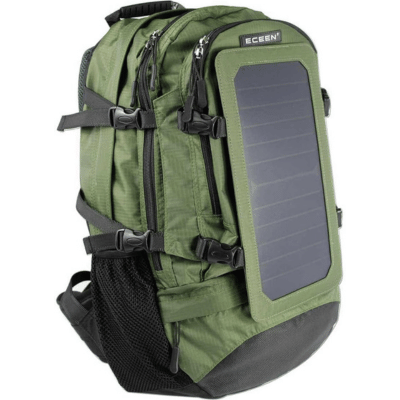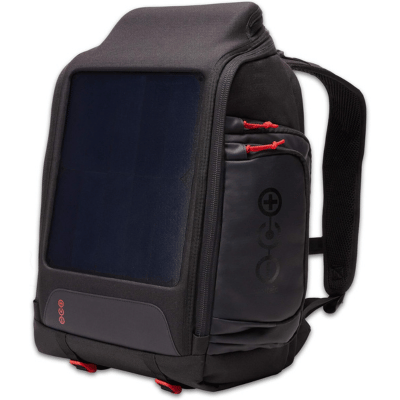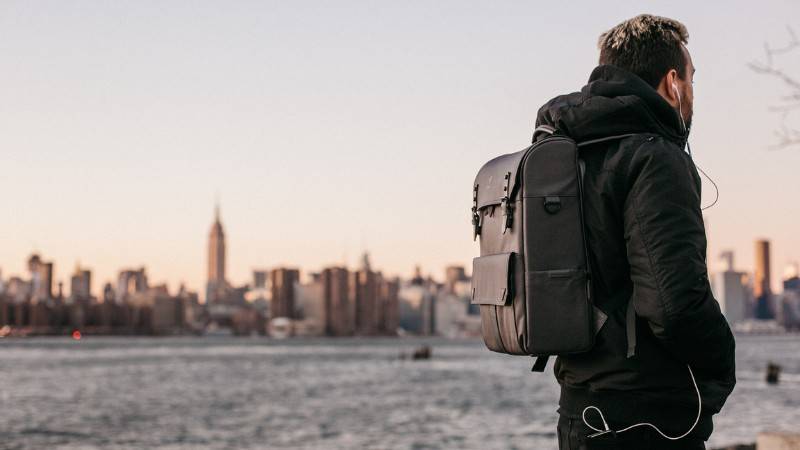Have you ever been hiking only to find that your smartphone is dead when you need it most? Maybe you’ve been taking photos in a remote location, only to find your DSLR camera battery is dead with no grid power for miles around?
Maybe you need a solar backpack.
Solar backpacks are kitted out with lightweight flexible solar panels that convert sunlight into solar energy stored in a battery pack. If you’re a hiker, photographer, camper, or you just like having green energy on tap, these backpacks are a great purchase.
And because sustainability is at the heart of what we do, we’re also spotlighting brands that go the extra mile. Not just in terms of performance, but in how they manufacture, source materials, and build products designed to last — all while reducing their environmental impact.
If you’re thinking about switching to a solar-powered pack, this blog is your one-stop guide to making a smarter, greener choice.
3 Best Solar Bagpack Brands You Can Consider
1. ECEEN: Making Solar Power More Portable for Everyday Use

ECEEN isn’t just about backpacks — it’s about bringing solar energy into daily routines without the steep learning curve. Their solar backpacks combine utility with clean energy, giving commuters, hikers, and travelers an easy way to charge devices on the go. Built with integrated solar panels and USB ports, ECEEN’s products help reduce reliance on grid power, even if just one charge at a time.
The brand doesn’t spotlight sustainability as a core message, but its products lean into practical eco-consciousness. Lightweight designs, integrated power solutions, and an emphasis on multi-use gear mean fewer single-function gadgets and less electronic waste over time.
While details around ECEEN’s supply chain and material sourcing are limited, their push toward energy independence through solar integration is worth noting. Their offerings support a shift toward personal renewable energy use — especially for those who are outdoorsy or always on the move.
If you’re looking for a straightforward way to dip into solar without a huge investment, ECEEN’s gear makes a strong case for functional sustainability in motion.
2. Sunnybag: Designing for Daily Solar Independence

Sunnybag isn’t just manufacturing solar gear — it’s building a lifestyle around personal renewable energy. With award-winning solar panels and thoughtfully designed backpacks, the brand empowers users to generate and store their own clean power wherever they are. Whether you’re hiking a trail or commuting through the city, Sunnybag makes solar energy feel accessible, portable, and even stylish.
What really sets Sunnybag apart is its focus on innovation with intention. Products like the LEAF PRO — a featherlight, flexible solar panel — are built for real-world durability and outdoor use, reducing the need for disposable charging gear or fossil-fuel-based backups. Their designs speak to a low-impact ethos: high efficiency, reliable output, and no extra bulk.
Sunnybag also works to educate consumers on cutting CO₂ emissions through solar adoption. While there’s limited public data on their supply chain ethics, the brand’s mission leans heavily into reducing reliance on conventional electricity, and their technology-forward designs help users live that mission every day.
For eco-conscious adventurers and tech-savvy commuters, Sunnybag offers solar gear that makes sustainability simple — and seriously effective.
3. Voltaic Systems: Built from Bottles, Powered by the Sun

Voltaic Systems has carved out a reputation as one of the most sustainability-driven tech brands in the solar backpack space. From the jump, they’ve prioritized using recycled PET fabric made from plastic bottles — a decision that speaks volumes about their commitment to reducing virgin plastic use and closing the materials loop.
But the eco-focus doesn’t stop at materials. Voltaic’s gear is modular and built for repair, not replacement. That means users can easily swap out parts, extend product life cycles, and keep gear in use longer — a subtle but powerful rejection of fast tech culture. Their long-life solar panels are tested for durability and efficiency, with a lifespan that easily outlasts standard throwaway electronics.
While Voltaic Systems doesn’t frame their brand around trendiness or aesthetic minimalism, their design philosophy is quietly revolutionary. From lifecycle planning to recycled materials, every product supports a future where tech and sustainability coexist.
If you’re after serious solar performance and brand-level environmental integrity, Voltaic Systems is a standout — practical, principled, and planet-forward.
What To Consider Before Buying A Solar Backpack
Solar Panel Quality
If you’re looking to charge your smartphone and other electronic devices, you need to make sure that the solar backpack has a solar panel that’s actually decent.
Loosely speaking, you ideally want to look for 5-watt solar panels (or higher) that produce 5V of power, as most smartphones charge at around 5V.
While higher wattages don’t always mean faster charging, it can help you out on cloudy days where sunlight is limited.
Phones can only accept charge up to a maximum rate of around 0.5A@5V. This means that over around 2.5W a larger panel will not charge your phone faster in bright sunlight. However, in poor light conditions a larger panel will continue to generate sufficient power when a less powerful panel will not.
Bag Size & Capacity
What are you going to use the backpack for? Different packs have different capacities because they’re designed for different uses and types of people.
For instance, a 15-liter backpack is perfect for small laptops and smartphones, while a 45-liter backpack has much more storage for campers, hikers, or professional photographers.
The best solar backpacks have the storage and capacity that you need, as well as the solar panels necessary to charge your particular devices.
Durability & Weatherproofing
Some backpacks referred to as the “best solar backpacks” actually have huge problems with durability and lifespan.
For example, you might find that your backpack’s battery dies after a few months, or you have problems with the USB port connections after a while. These electronic issues are common with cheaper solar backpacks especially.
You also need to consider weatherproofing — not all backpacks are waterproof, and you don’t want your digital devices to get damp or wet, right?
Charging Time
How long will it take your solar-powered backpack to charge your devices?
If you’re relying solely on solar power, you need to carefully check how long it will take you to get the power you need.
The best solar backpacks at the higher end of the price scale will usually be able to charge your smartphone fully in 2-3 hours of sunlight, while cheaper backpacks with subpar solar panels will usually charge a smartphone battery in 5-6 hours or more.
Of course, the sunlight conditions make a large difference, but some solar panels charge devices significantly faster than others.
Wall Outlet Charging
While a solar-powered backpack is a brilliant piece of kit, it requires you to have the backpack outside in good sunlight conditions for several hours per day.
Unless you’re a hiker, that just isn’t practical.
As such, it’s good to buy a solar pack with a power bank that has AC outlet charging capabilities, meaning it can be charged from either the solar panels or a regular wall AC outlet.
Many people, myself included, use their solar backpack’s solar energy as a sort of “top up” to help keep the power bank topped up when walking around.
Removable Solar Panels
Some solar backpacks have removable solar panels instead of sewn-in ones.
This makes it easier for you to leave the solar panel in direct sunlight (perhaps on a rock or window sill) while you use the rest of the backpack to do things.
Detachable solar panels make it easier to get solar power for your devices, especially if you spend most of your time indoors away from sunlight.
However, if you’re a hiker, camper, or adventurer who’s going to spend most of their time outdoors wearing the backpack, then this feature won’t matter as much to you.
What Is A Solar Backpack?
A solar backpack is a backpack that comes with an integrated solar panel on the back, allowing it to charge and receive solar energy from the sun as you wear it on your back outside.
Some of these backpacks have their solar panels sewn in, whereas others have detachable panels that you can place elsewhere to charge while you do other things.
This solar energy can be used to charge devices like smartphones, tablets, laptops, cameras, and more.
Some solar backpacks come with power banks included, meaning that the solar energy can be stored in the power bank and then used whenever you need to charge your devices. Other solar backpacks force you to charge your devices with the solar energy immediately — you can’t store it for later.
These solar-powered backpacks come in various sizes depending on your needs — you can get small 15-liter backpacks designed for laptops and tablets, or you can get larger 40-liter and above bags designed for camping, hiking, and outdoor pursuits.
Certain solar backpacks with power banks may allow you to charge up the power bank from an AC wall outlet as well as from sunlight. It’s often a good idea to use a combination of the two.
How Do Solar Backpacks Work?
Solar backpacks are equipped with a flexible solar panel made from monocrystalline.
They also come with a battery, charge controller, various leads/cables, and they may also come with a power bank to store the energy for use at a later time.
Most decent solar backpacks can provide 120 watts of energy per day — enough to charge most your smaller digital devices (smartphones, tablets, etc.)
The bags work because of technology in the panels called photovoltaic cells (PV cells).
When sunlight hits the panel, electrical energy is created in the semiconductor. This is then sent to the charge controller or the lithium-ion battery for later use, depending on how your solar backpack works.
Types Of Solar Backpacks
Most solar backpacks use a pretty standard setup reminiscent of the days that they were used in the military, where they first got their start.
You can expect a decent amount of storage space ideal for camping/hiking equipment, in addition to the flexible solar panel, powerbank, and a couple of USB ports for your devices.
With this setup, you can expect 120 watts of power per day on a 12-hour charge, assuming sunlight conditions are good. This is enough to charge most smartphones and smaller digital devices at least a couple of times. Many of these outdoor-style backpacks also have features like built-in LED lights.
In modern times, more urban-centered solar backpacks are becoming available. These backpacks tend to be smaller in capacity (20 liters or less) and have special storage compartments for laptops, tablets, and other digital devices. These backpacks often come with anti-theft features to deter against pickpockets.
Some solar backpacks, whether designed for outdoors or city life, come with detachable solar panel kits that allow you to charge up the panels separately from the bag. This is useful if you don’t spend that much time walking around in direct sunlight.
Benefits Of A Solar Backpack
Green Energy
This being GreenCitizen, we have to say that the biggest upside of these backpacks is that they produce green renewable energy that isn’t dependent on grid power, which is often made with fossil fuels.
These backpacks also don’t have byproducts or fumes that are released into the atmosphere, so pollution is reduced too.
Lightweight
Most sun-powered bags are very lightweight, designed with portability in mind.
The panels used for capturing energy from the sun are usually made from lightweight, flexible materials. This means that you don’t need to worry about the bag bending in unusual positions too much.
Most of these bags are 2lbs or less when they’re empty, so they’re very easy to sling over your shoulder without feeling like you’re being weighed down.
Charges All Your Devices
The most obvious benefit of sun-powered bags is their ability to help you charge your devices when you’re camping, hiking, or just not near convenient grid power.
Most of these products have at least 1 or 2 USB ports that allow you to connect your smartphone or tablet to charge.
Some bags also allow you to charge slightly larger devices like laptops and DSLR camera batteries.
Weatherproof
Most sun-powered bags are designed to be weatherproof and water-resistant, at least to some degree. This is because the solar panels must be able to absorb sunlight without getting damaged by rain, hail, and other adverse weather.
Weatherproofing also has the added benefit of helping to keep your possessions and digital devices safe from the elements inside your bag.
However, cheaper bags might not have this feature, so bear this in mind.
Easy To Use
Generally speaking, you don’t need to be a professional hiker or long-time outdoors-y type in order to use a solar pack. These products are designed to be easy to use for everyday people who don’t know their charge controller from their watt-hours.
So yeah, if you’ve got the ability to turn on a laptop and send some emails, you will be able to use one of these bags just fine.
Frequently Asked Questions (FAQ)
To make a solar backpack, you would need a regular bag, a flexible solar panel, a battery, and all the necessary cables. Attach the solar panel to the back of the bag and hide the battery and wiring inside the storage compartments. Voila!
The solar backpack may have been invented by Job Bihn, who filed a patent for the design back in 2006. However, it’s hard to know for sure who came up with the design first.
You attach solar panels to a backpack with double-sided adhesive tape. Heavy-duty tape is preferable, especially if you live in an area prone to rain and bad weather. Double-sided tape allows you to maximize the surface area of the panels exposed to sunlight.
Choose a Solar Backpack That Charges More Than Just Your Devices
A solar backpack isn’t just about convenience — it’s about choosing a product that aligns with a sustainable lifestyle. Whether you’re drawn to the eco-friendly materials, energy independence, or sheer functionality, these packs offer more than portable power — they offer purpose.
By understanding how solar backpacks work, knowing what to look for, and choosing brands with strong environmental values, you’re investing in gear that supports both your goals and the planet.
Ready to make the switch? Explore durable, ethically made solar backpacks that support renewable energy — one sunny charge at a time.


